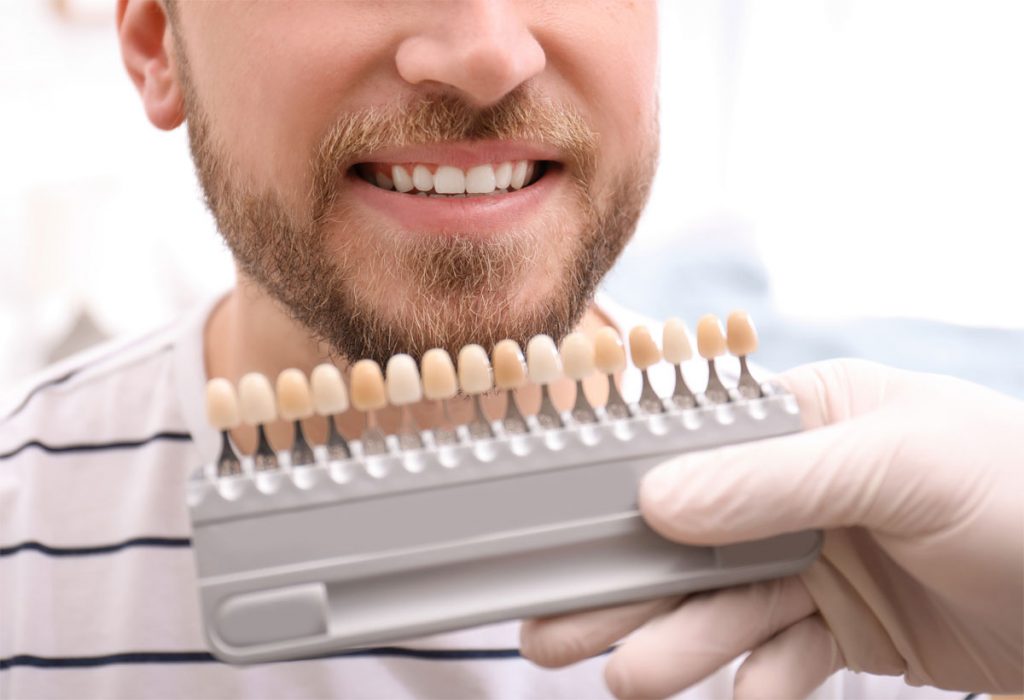A study in 2015 showed that over 80% of people think their teeth look BAD in photographs. It also found that nearly 30% of people don’t show their teeth when smiling in photos on social media because they don’t like the way their teeth look.
That’s a lot of people that are unhappy with the look of their teeth! Sometimes braces can help fix issues that make people unhappy with their smile, like overbites and underbites, but sometimes people just want bigger, brighter teeth. For those people, veneers are usually a great option, but what are veneers?
What are Veneers?
Unlike crowns, veneers are usually made of thin pieces of porcelain that can be bonded to your teeth in order to improve the overall look of your smile. The best part? The treatment can be completed in as little as two visits and the veneers are individually crafted and customized to fit your smile. Basically, they look completely natural when the treatment is finished. If you are unhappy with the look of your smile in photos, veneers will solve that problem.
How do Veneers Work?
The American Academy of Cosmetic Dentistry describes veneers as a similar process to re-siding your house. Overtime the siding on your home can become weathered, damaged, and just start to look dingy and old. Replacing the siding immediately improves the overall aesthetics and curb appeal of your home without having to tear down the home and rebuild it. Veneers are like re-siding your teeth. Your teeth are still strong but the veneers makes your smile look brand new again, improving your smiles “curb appeal”.
Veneers are a great cosmetic solution for many problems that people have with their teeth, including; gaps, chips, spaces, length, and color of teeth.
Unhappy about how short your teeth are? Veneers can lengthen them.
Unhappy with the spacing of your teeth? Veneers can cover them.
You get the idea. Veneers can solve most cosmetic issues with your teeth!
Veneers are a cosmetic treatment and it is virtually painless. It is important to know that traditional veneers are not reversible. Meaning, once you decide to get them, you can’t go back to your “old” smile. There are veneer treatments called “no-prep veneers” that can be removed, making them nearly reversible, but there are limitations to this treatment option so it’s something to discuss with your dentist before getting started.
Getting Started with Veneers
So how do you get started with veneers? The first step is a consultation with one of our cosmetic dentists. You will sit down and explain everything you love, like and dislike about your smile. We want to hear about your goals and the main reason why you looked in the mirror today and decided to search for this article and then book a cosmetic consultation with us in the hope of improving the look of your smile. The dentist will discuss some options with you and offer a recommended treatment plan based on the information you’ve provided.
You will also get the estimated cost of the treatment plan from your dentist.
If you are happy with the plan then the next step is to book your treatment – setting the date that you will finally get your brand new smile.
If you are considering a smile-makeover then you probably have some questions. Here are some of the frequently asked questions that we hear from patients:
How much do veneers cost?
The cost of veneers can vary based on the material and treatment used but expect anywhere from $1000 to $1500 per veneer. Most people get 6-8 veneers so it can get expensive. However, many dental offices do offer discounts for getting 4 or more veneers at the same time.

How long do veneers last?
Like your real teeth, veneers are not indestructible. They are very strong though and, with proper care, veneers can last 10-20 years. Proper care includes brushing and flossing, and avoiding hard or sticky foods. You will also want to try to avoid grinding your teeth or putting unnecessary wear and tear on them.
Does insurance cover veneers?
Most dental insurances only cover treatments that are medically necessary. For example, you have a cavity that needs to be filled or had an accident that resulted in a damaged tooth. Most insurances will not cover elective treatments that are solely for cosmetic purposes. That being said, there are many cosmetic treatments that can be deemed medically necessary. Speak with your dental team’s insurance specialist to learn more about your options, which will vary depending on your insurance.
What Happens if you don’t like your veneers?
This problem doesn’t usually come up because you will get to see your veneers before they go in. You will also get to see what you will look like with this new smile. The treatment is NOT reversible so it’s important to let your dentist know what you think of your smile’s new siding before beginning the treatment.
Have questions about veneers or another cosmetic dentistry treatment? If you live in Illinois then contact one of our Chicago dentist offices and we’ll be happy to get you scheduled for a free consultation to discuss veneers as an option for your smile.



